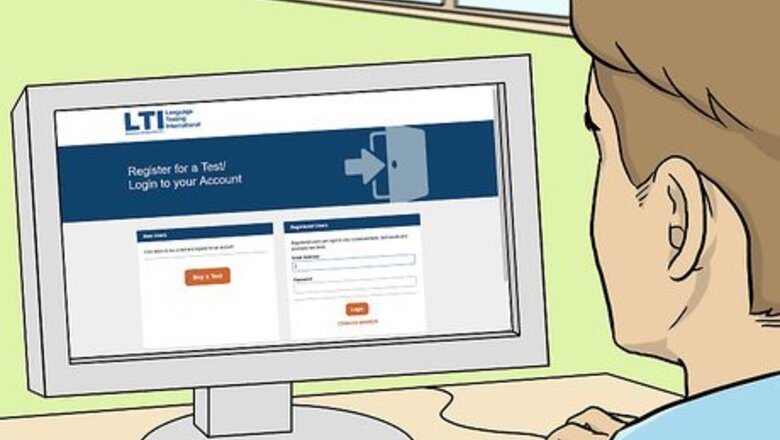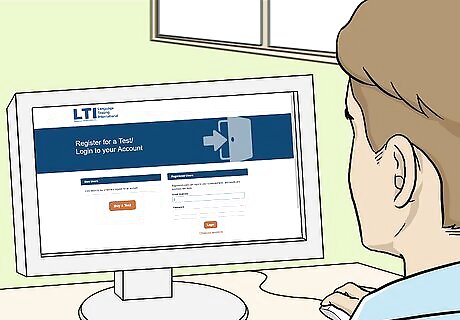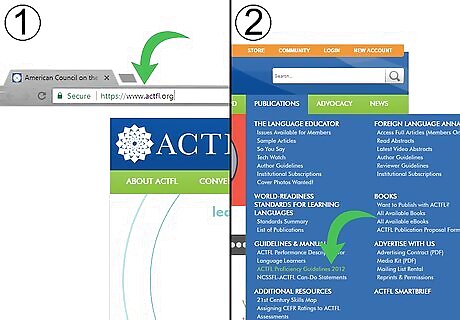
views
X
Research source
Signing Up for the Test

Set up an online account. Language Testing International (LTI) holds an exclusive license to administer the OPIc test. To take the test, you must create an account at https://tms.languagetesting.com/IndividualSite/. Once you create a user name and password, you can sign up to take the test. If you also need a teaching certificate, make sure to click through the link for your state.

Make arrangements with a proctor. If you're taking the OPIc, you'll be asked questions over the internet by a computer-simulated voice. However, a proctor is required to be present to observe you as you take the test. The proctor must be someone who holds a supervisory position at the school where you take the test. They must be able to provide you with a quiet room to take the test, equipped with a computer connected to the internet and a headset with a working microphone. When you sign up to take the test on the LTI website, you'll have to give them your proctor's name and title, as well as their contact information.

Choose a time to take the test. The OPIc test is administered on an individual, as-needed basis. There aren't specific times scheduled when you have to take the test. Instead, you supply three dates and times when you will be available. The reason you're giving three dates is so your proctor can confirm the best time when they will be available and have the facilities and equipment you need to take the test. The earliest of the dates you choose must be at least 10 days from the date you submit your application to take the test. Make sure you have at least three hours of availability on the dates and times you select.

Complete your self assessment. Read through the six descriptions provided by LTI and choose the one that most accurately represents how well you speak the language you're going to be tested on. The level you choose determines the test you are given. If you're taking the OPIc for work, or for academic certification purposes, there may be a specific level that you're required to demonstrate. Make sure you know if you need to demonstrate a minimum level of proficiency.

Receive email confirmation. Once you've paid any fees and the date and time for your test has been scheduled, LTI will send you an email. Keep this email, as it includes information you will need on the day of the test. Review the location listed and name of your proctor to make sure they are correct. The email provides the ID and access code you'll need to use to pull up the test on the computer on test day. You may want to print off a copy of the email and keep it in a safe place so you can be sure you'll have it.
Studying for the Test

Read the ACTFL Proficiency Guidelines carefully. The Proficiency Guidelines let you know exactly what will be tested for each proficiency level and what you must demonstrate if you want to achieve that level of proficiency. You can download a copy of the most recently updated Proficiency Guidelines from the ACTFL website, at https://actfl.org. Click on the "publications" tab and select the ACTFL proficiency guidelines.

Sign up for a test prep course. Some university language departments offer courses specifically designed to help you prepare to take the OPIc test. Check colleges and universities near you to see if a course is available in your chosen language. If you're taking the OPIc test to be a foreign language teacher, there may be prep courses available within your program, although there may be an additional charge for these courses beyond your regular tuition.

Practice speaking often. The OPIc test evaluates your ability to speak and carry on a conversation. The best way to prepare really is to have as many conversations as you can in that language, until you feel natural and comfortable speaking it. Try to immerse yourself in the language, particularly in the weeks leading up to the test. This will help you think and reason faster in the language. If you know people who are fluent in the language, tell them that you only want to communicate with them in that language. That can help you prepare for the test as well as get advice on your speaking style.

Review how the test is structured. The OPIc test is split into four phases, regardless of what level of proficiency you're trying to reach. The test starts with informal warm-up questions, then moves into more difficult questions before winding down. The second and third phases of the test are where you'll really be challenged and have the opportunity to demonstrate your speaking ability. The third phase is designed to push you to the outer limits of your speaking ability. You'll be given between 12 and 17 questions, each with varying time limits to respond depending on the difficulty level of the question. Expect the test to take you between 30 and 40 minutes to complete.

Take a demo. Since each test is different, there aren't really any practice OPIc tests you can take. However, LTI does offer a short demo that can help you get familiar with the computer-simulated voice and the basic structure of the test. Go to the LTI website at www.languagetesting.com and click on "tests." When you choose the test you're going to take, you'll have access to any available manuals and demos to help you prepare.

Watch clips of people taking the test. LTI also offers video clips that you can watch if you want to see what kind of answers correspond to various levels of proficiency. While you will be asked different questions, you can still learn from the depth to which the test-takers answered the questions they were asked. Don't worry if the person taking the test seems to know more about a particular topic than you do. The point of the test is to evaluate your ability to speak, not your level of knowledge about any particular subject.
Taking the Test

Bring identification. Before you can take the test, your proctor will have to verify your identity. Check your confirmation email or contact your proctor to find out what forms of identification are acceptable. Since your test is an oral test, you don't really have to bring any other materials (apart from your access code). You won't be allowed to have notes or other written materials in the testing room.

Enter your access code. You will have a computer connected to the internet with a headset and microphone. Your proctor may want you to test the equipment to make sure it works, and then you'll type in the ID and access code from your confirmation email.

Listen carefully. You'll only hear the questions once, and then you'll have to start talking. Actively listen to the question rather than trying to come up with your answer at the same time. Reinforce specific prompts and tasks in your mind. Some questions or prompts may have multiple parts, or tasks that must be covered for your answer to be considered complaint. The more advanced the prompt is, the longer it generally will take for you to respond.

Answer every question. When the prompt has ended, take a moment to gather your thoughts before you start speaking. You need to provide some answer to every question or prompt, even if you know little to nothing about the subject mentioned. If you find you've frozen up or are having difficulty getting started, take a few deep breaths and restate the question. That may help you focus your thoughts and get your brain working in that language.

Provide the best answer you can. It may be that you forget part of a complicated question, or that you're asked a question on a topic with which you're unfamiliar. In those situations, be as detailed as possible. Remember the test is designed to measure your ability to communicate in that language – you're not being tested on what you may know about a particular subject. If you're asked about something you don't know anything about, talk about how you're unfamiliar with the topic, and the things you would like to learn about it. Likewise, if you forget part of the question, it's fine to address the rest of the question and say that you forgot part of it. Think about how you would handle that situation if you were having a normal conversation, rather than responding to a test prompt. Tailor your response so it's as natural and conversational as possible.

Speak as much as possible. The OPIc test is designed to measure your speaking proficiency, so the more you speak the more the evaluators have to work with. Include as many details as possible, while maintaining a normal flow of conversation as much as possible. It can help to think of an example, such as a story you heard or an experience you had, that can illustrate a general statement you made in response to a prompt.


















Comments
0 comment